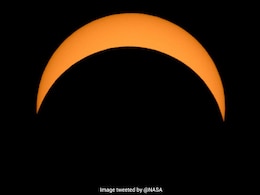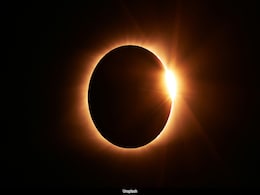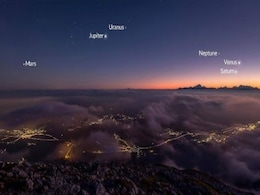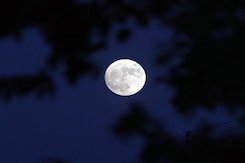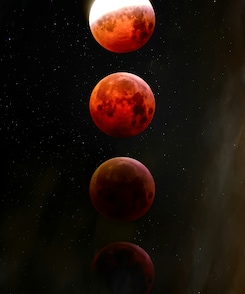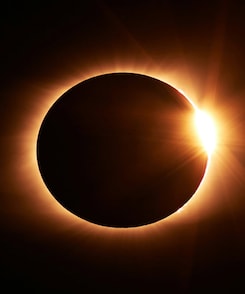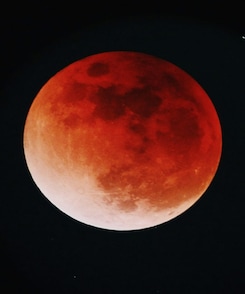Celestial Event
- All
- News
- Videos
- Web Stories
-

Solar Eclipse 2025: Best Viewing Locations, Safety Tips And How To Watch
- Friday March 28, 2025
- Science | Edited by Bhavya Sukheja
Skywatchers and astronomy enthusiasts are in for a spectacular celestial event as a partial solar eclipse is set to take place on March 29, Saturday.
-
 www.ndtv.com
www.ndtv.com
-

Solar Eclipse On March 29: Will It Be Visible In India? All You Need To Know
- Wednesday March 26, 2025
- Science | Edited by Bhavya Sukheja
A partial solar eclipse is set to take place on Saturday, March 29. This celestial event will be the first solar eclipse of 2025.
-
 www.ndtv.com
www.ndtv.com
-

Saturn's Rings To 'Disappear' Today In A Rare Celestial Event, Here's Why It Happens
- Sunday March 23, 2025
- Science | Edited by Ritu Singh
The rare phenomenon will start on Sunday, March 23, at 12:04 p.m. EDT (9:34 pm in India) and extend for a few days.
-
 www.ndtv.com
www.ndtv.com
-

First Solar Eclipse Of 2025 This Month, Will It Be Visible From India?
- Monday March 10, 2025
- World News | Edited by NDTV News Desk
The first solar eclipse of the year is set to occur on March 29. The celestial event takes place when the Moon is closer to Earth and passes directly between the Earth and the Sun, blocking sunlight and casting a shadow on Earth's surface.
-
 www.ndtv.com
www.ndtv.com
-

T Coronae Borealis Nova Event: When and Where to See the 'Blaze Star'
- Wednesday March 5, 2025
- Written by Gadgets 360 Staff
T Coronae Borealis, also known as the 'Blaze Star,' is predicted to undergo a rare nova event, briefly making it visible to the naked eye. This recurrent nova, last seen erupting in 1946, is expected to brighten anytime between now and late 2024. Positioned in the constellation Corona Borealis, the star will be best visible a few hours after sunset...
-
 www.gadgets360.com
www.gadgets360.com
-

Planetary Parade 2025: Rare Photo Captures Earth And 7 Planets For The First Time Ever
- Thursday February 27, 2025
- Science | Edited by Ritu Singh
Experts have claimed it could be the first time all planets including Earth have been captured in a single image.
-
 www.ndtv.com
www.ndtv.com
-

Rare Seven-Planet Alignment 2025: How to Watch in India, Best Viewing Tips
- Monday February 24, 2025
- Written by Gadgets 360 Staff
A rare celestial event featuring seven planets—Mercury, Venus, Mars, Jupiter, Saturn, Uranus, and Neptune—aligning along the ecliptic will be visible in 2025. The alignment starts on February 28, with the best viewing in India on March 3. Venus and Jupiter will be easily visible, while Uranus and Neptune will require a telescope. Experts sugges...
-
 www.gadgets360.com
www.gadgets360.com
-

7 Planets To Align Next Week, Here's How To Watch This Rare Celestial Event From India
- Friday February 21, 2025
- Science | Edited by Bhavya Sukheja
A rare celestial event is set to occur on February 28, when all planets in our solar system will be visible in the night sky briefly.
-
 www.ndtv.com
www.ndtv.com
-

A Star With a Planet May Be Racing Through the Galaxy at Record Speed
- Wednesday February 12, 2025
- Written by Gadgets 360 Staff
Astronomers have identified a potential record-breaking exoplanet system moving at 1.2 million mph. Detected through microlensing, the discovery suggests a low-mass star with an orbiting planet is racing through the Milky Way. Data from the Keck Observatory and ESA’s Gaia satellite indicate a high-speed celestial body that may eventually escape t...
-
 www.gadgets360.com
www.gadgets360.com
-

February 2025 Planet Parade: How to See Five Planets Align in the Sky
- Wednesday February 5, 2025
- Written by Gadgets 360 Staff
A rare celestial event will unfold in February 2025, with five bright planets—Venus, Jupiter, Mars, Mercury, and Saturn—visible in the evening sky. The highlight occurs on February 24, when Mercury and Saturn appear closest. Uranus and Neptune can also be observed with telescopes. Best viewing conditions require a clear west-southwest horizon a...
-
 www.gadgets360.com
www.gadgets360.com
-

Comet 2024 G3 (ATLAS) Becomes the 'Great Comet' of 2025 with Stunning Display
- Thursday January 30, 2025
- Written by Gadgets 360 Staff
Comet 2024 G3 (ATLAS) has captured the attention of astronomers with its incredible brightness and distinct tail structure. First observed in 2024, it became the brightest comet in 18 years, and it even reached a rare feat of being visible during daylight. This comet, which passed closest to the sun in January 2025, has earned the title of "Great C...
-
 www.gadgets360.com
www.gadgets360.com
-

Planetary Parade 2025: How And Where To See This Rare Celestial Event In India
- Saturday January 25, 2025
- Science | Edited by Bhavya Sukheja
Stargazers are in or a treat as six planets - Venus, Mars, Jupiter, Saturn, Neptune, and Uranus - are set to align in the night sky today, January 25, offering a spectacular view.
-
 www.ndtv.com
www.ndtv.com
-

Planetary Parade: 6 Planets To Align In Rare Celestial Event. How To Watch
- Tuesday January 21, 2025
- World News | Edited by NDTV News Desk
A rare celestial event, where six planets will align in the night sky and be seen with the naked eye, will unfold in the next few days.
-
 www.ndtv.com
www.ndtv.com
-

Mark Your Calendars! The Next Blue Moon Arrives on May 31, 2026
- Monday January 13, 2025
- Written by Gadgets 360 Staff
The next Blue Moon is set to occur on May 31, 2026, offering a rare celestial event where a second full moon appears within a single calendar month. This type, known as a monthly Blue Moon, arises due to the 29.5-day lunar cycle misaligning with the Gregorian calendar. While the term suggests rarity, it has historical roots and does not mean the mo...
-
 www.gadgets360.com
www.gadgets360.com
-

Solar Eclipse 2025: Best Viewing Locations, Safety Tips And How To Watch
- Friday March 28, 2025
- Science | Edited by Bhavya Sukheja
Skywatchers and astronomy enthusiasts are in for a spectacular celestial event as a partial solar eclipse is set to take place on March 29, Saturday.
-
 www.ndtv.com
www.ndtv.com
-

Solar Eclipse On March 29: Will It Be Visible In India? All You Need To Know
- Wednesday March 26, 2025
- Science | Edited by Bhavya Sukheja
A partial solar eclipse is set to take place on Saturday, March 29. This celestial event will be the first solar eclipse of 2025.
-
 www.ndtv.com
www.ndtv.com
-

Saturn's Rings To 'Disappear' Today In A Rare Celestial Event, Here's Why It Happens
- Sunday March 23, 2025
- Science | Edited by Ritu Singh
The rare phenomenon will start on Sunday, March 23, at 12:04 p.m. EDT (9:34 pm in India) and extend for a few days.
-
 www.ndtv.com
www.ndtv.com
-

First Solar Eclipse Of 2025 This Month, Will It Be Visible From India?
- Monday March 10, 2025
- World News | Edited by NDTV News Desk
The first solar eclipse of the year is set to occur on March 29. The celestial event takes place when the Moon is closer to Earth and passes directly between the Earth and the Sun, blocking sunlight and casting a shadow on Earth's surface.
-
 www.ndtv.com
www.ndtv.com
-

T Coronae Borealis Nova Event: When and Where to See the 'Blaze Star'
- Wednesday March 5, 2025
- Written by Gadgets 360 Staff
T Coronae Borealis, also known as the 'Blaze Star,' is predicted to undergo a rare nova event, briefly making it visible to the naked eye. This recurrent nova, last seen erupting in 1946, is expected to brighten anytime between now and late 2024. Positioned in the constellation Corona Borealis, the star will be best visible a few hours after sunset...
-
 www.gadgets360.com
www.gadgets360.com
-

Planetary Parade 2025: Rare Photo Captures Earth And 7 Planets For The First Time Ever
- Thursday February 27, 2025
- Science | Edited by Ritu Singh
Experts have claimed it could be the first time all planets including Earth have been captured in a single image.
-
 www.ndtv.com
www.ndtv.com
-

Rare Seven-Planet Alignment 2025: How to Watch in India, Best Viewing Tips
- Monday February 24, 2025
- Written by Gadgets 360 Staff
A rare celestial event featuring seven planets—Mercury, Venus, Mars, Jupiter, Saturn, Uranus, and Neptune—aligning along the ecliptic will be visible in 2025. The alignment starts on February 28, with the best viewing in India on March 3. Venus and Jupiter will be easily visible, while Uranus and Neptune will require a telescope. Experts sugges...
-
 www.gadgets360.com
www.gadgets360.com
-

7 Planets To Align Next Week, Here's How To Watch This Rare Celestial Event From India
- Friday February 21, 2025
- Science | Edited by Bhavya Sukheja
A rare celestial event is set to occur on February 28, when all planets in our solar system will be visible in the night sky briefly.
-
 www.ndtv.com
www.ndtv.com
-

A Star With a Planet May Be Racing Through the Galaxy at Record Speed
- Wednesday February 12, 2025
- Written by Gadgets 360 Staff
Astronomers have identified a potential record-breaking exoplanet system moving at 1.2 million mph. Detected through microlensing, the discovery suggests a low-mass star with an orbiting planet is racing through the Milky Way. Data from the Keck Observatory and ESA’s Gaia satellite indicate a high-speed celestial body that may eventually escape t...
-
 www.gadgets360.com
www.gadgets360.com
-

February 2025 Planet Parade: How to See Five Planets Align in the Sky
- Wednesday February 5, 2025
- Written by Gadgets 360 Staff
A rare celestial event will unfold in February 2025, with five bright planets—Venus, Jupiter, Mars, Mercury, and Saturn—visible in the evening sky. The highlight occurs on February 24, when Mercury and Saturn appear closest. Uranus and Neptune can also be observed with telescopes. Best viewing conditions require a clear west-southwest horizon a...
-
 www.gadgets360.com
www.gadgets360.com
-

Comet 2024 G3 (ATLAS) Becomes the 'Great Comet' of 2025 with Stunning Display
- Thursday January 30, 2025
- Written by Gadgets 360 Staff
Comet 2024 G3 (ATLAS) has captured the attention of astronomers with its incredible brightness and distinct tail structure. First observed in 2024, it became the brightest comet in 18 years, and it even reached a rare feat of being visible during daylight. This comet, which passed closest to the sun in January 2025, has earned the title of "Great C...
-
 www.gadgets360.com
www.gadgets360.com
-

Planetary Parade 2025: How And Where To See This Rare Celestial Event In India
- Saturday January 25, 2025
- Science | Edited by Bhavya Sukheja
Stargazers are in or a treat as six planets - Venus, Mars, Jupiter, Saturn, Neptune, and Uranus - are set to align in the night sky today, January 25, offering a spectacular view.
-
 www.ndtv.com
www.ndtv.com
-

Planetary Parade: 6 Planets To Align In Rare Celestial Event. How To Watch
- Tuesday January 21, 2025
- World News | Edited by NDTV News Desk
A rare celestial event, where six planets will align in the night sky and be seen with the naked eye, will unfold in the next few days.
-
 www.ndtv.com
www.ndtv.com
-

Mark Your Calendars! The Next Blue Moon Arrives on May 31, 2026
- Monday January 13, 2025
- Written by Gadgets 360 Staff
The next Blue Moon is set to occur on May 31, 2026, offering a rare celestial event where a second full moon appears within a single calendar month. This type, known as a monthly Blue Moon, arises due to the 29.5-day lunar cycle misaligning with the Gregorian calendar. While the term suggests rarity, it has historical roots and does not mean the mo...
-
 www.gadgets360.com
www.gadgets360.com


